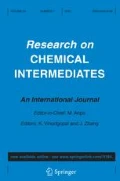Abstract
Thioacetamide (TA) is an organic compound having thioamide group similar to that in thiourea derivatives. Its reactions with e −aq , H-atom and OH radicals were studied using the pulse radiolysis technique at various pHs and the kinetic and spectral characteristics of the transient species were determined. The initial adduct formed by the reaction of TA with OH radicals at pH 7 does not absorb light in the 300–600 nm region but reacts with the parent compound to give a transient species with an absorption maximum around 400 nm. At pH 0, the reaction of OH radicals with TA directly gives a similar transient species with absorption maximum at 400 nm. Transient species formed by H-atom reaction with TA and pH 0 has no absorption in the 300–600 nm region but at higher acidity a new transient species is formed which has absorption maximum at 400 nm. This transient absorption observed in the case of both OH and H atom reaction with TA is ascribed to the formation of a resonance stabilized radical similar to that obtained in the case of thiourea derivatives. The species produced by electron reaction viz. electron adduct was found to be a strong reductant and could reduce MV2+ with a high rate constant. H2S was produced as a stable product in the reaction of e −aq and its G-value was determined to be about 0.8.
Similar content being viewed by others
References
S.N. Raicheva, B.V. Aleksiev, and E.I. Sokolova, Corrosion Science 34, 343 (1993).
O.G. Fitzhugh and A.A. Nelson, Science 108, 626 (1948); R.G. Klienfield, Cancer Res. 17, 954 (1952); W.J. Steel, N. Okamura, and H. Bausch, J. Biol. Chem. 240, 1742 (1965).
O.K. Sharma, Science 202, 68 (1978).
J.F.L. Childs and E.A. Siegler, Science 102, 68 (1945).
E. Hayon, T. Ibata, N.N. Lichtin, and M. Simic, J. Am. Chem. Soc. 92, 3898 (1970).
K.-D. Asmus. In: Methods in Enzymology 186, 168 (1990).
G.R. Dey, D.B. Naik, K. Kishore, and P.N. Moorthy, J. Chem. Soc. Perkin Trans. 2 1625 (1994).
G.R. Dey, D.B. Naik, K. Kishore, and P.N. Moorthy, Radiat. Phys. Chem. 43, 365 (1994).
S.N. Guha, P.N. Moorthy, K. Kishore, D.B. Naik, and K.N. Rao, Proc. Indian. Acad. Sci. (Chem. Sci.) 99, 261 (1987).
E.M. Fielden. In: The Study of Fast Processes and Transient Species by Electron Pulse Radiolysis, J.H. Baxendale and F. Busi (Eds.), D. Riedel Publishing Co. Dordrecht, 1982, p. 49.
R.R. Hentz, Farhataziz, and E.M. Hansen, J. Chem. Phys. 57, 2859 (1972).
G.D. Watt and A. Burns, Biochem. J. 152, 33 (1975).
D.R. Lide, CRC Handbook of Physics and Chemistry, 74th Edition, 1993–94, p. 8–23.
D.D. Perrin. In: Dissociation Constants of Organic Bases in Aqueous Solutions, Butterworths, London, 1965, p. 17.
Author information
Authors and Affiliations
Rights and permissions
About this article
Cite this article
Kishore, K., Dwibedy, P., Dey, G.R. et al. Nature of the transient species formed during pulse radiolysis of thioacetamide in aqueous solutions. Res. Chem. Intermed. 24, 35–45 (1998). https://doi.org/10.1163/156856798X00177
Received:
Accepted:
Issue Date:
DOI: https://doi.org/10.1163/156856798X00177




